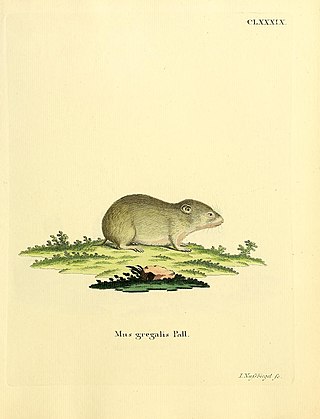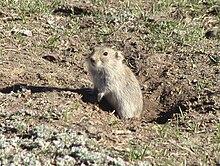Mandarin or The Mandarin may refer to:
Voles are small rodents that are relatives of lemmings and hamsters, but with a stouter body; a longer, hairy tail; a slightly rounder head; smaller eyes and ears; and differently formed molars. They are sometimes known as meadow mice or field mice in North America.

The Arvicolinae are a subfamily of rodents that includes the voles, lemmings, and muskrats. They are most closely related to the other subfamilies in the Cricetidae. Some authorities place the subfamily Arvicolinae in the family Muridae along with all other members of the superfamily Muroidea. Some refer to the subfamily as the Microtinae or rank the taxon as a full family, the Arvicolidae.

The Orkney vole is a population of the common vole found in the Orkney Islands, off the northern coast of Scotland, as well as in the Channel Island of Guernsey. Orkney voles are about 10% larger than voles from other populations of the common vole. The common vole is absent from the rest of the British Isles.

The mandarin vole is a species of vole found in central China as well as the southern and central Korean Peninsula. An adult mandarin vole is typically of about 115 millimeters in length, in addition to about 28 mm of tail. It is smaller and darker in color than the reed vole, Microtus fortis.

Alticola is a genus of rodent in the family Cricetidae.

Eothenomys is a genus of rodent in the family Cricetidae. It contains the following species:
The Ganzu vole, Eva's red-backed vole, Eva's vole, Gansu vole, or Taozhou vole is a species of rodent in the family Cricetidae. It is found in mountain forests in China. The IUCN has assessed it as being of "least concern".
The Shansei vole is a species of rodent in the family Cricetidae. It is found only in north-central China where its habitat is forests.

Brandt's vole,, also known as the steppe vole, is a species of rodent in the family Cricetidae. It is native to shrublands and grasslands in Russia, Mongolia and northern China.

The narrow-headed vole is a species of rodent in the family Cricetidae. It was previously placed in the genus Microtus, but modern listings either lump this into genus Lasiopodomys or split it out into Stenocranius. It ranges over northern and central Asia.
The Chinese scrub vole, or Irene's mountain vole, is a species of rodent in the family Cricetidae. It is endemic to mountainous parts of southern China and is very similar to the Sikkim mountain vole in appearance. The International Union for Conservation of Nature has assessed its conservation status as being of "least concern".
Smith's vole is a species of rodent in the family Cricetidae. It is also known as Smith's red-backed vole and is found only in Japan.
The Duke of Bedford's vole is a species of rodent in the family Cricetidae. After the Liangshan vole was removed from this genus, the Duke of Bedford's vole became the only member of the genus Proedromys. It is found only in mountainous parts of central China. It is a rare species and the International Union for Conservation of Nature has assessed its conservation status as being "vulnerable".
Neodon is a genus of rodent in the family Cricetidae. Species within Neodon are classified as relics of the Pleistocene epoch because the occlusal patterns resemble the extinct Allophaiomys.
The Lake Baikal mountain vole or Olkhon mountain vole is a species of rodent in the family Cricetidae. It is found principally on the Olkhon and Ogoi islands on Lake Baikal, in southern Siberia. While it was originally described as a species, Pavlinov and Rossolimo reassigned it as a subspecies of A. tuvinicus in 1987 before reinstating it as a species in 1998.

Microtini is a tribe of voles in the subfamily Arvicolinae.








